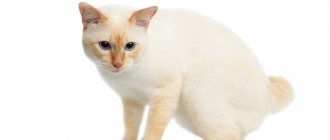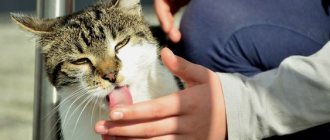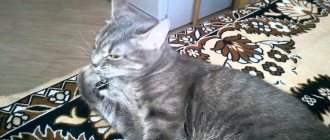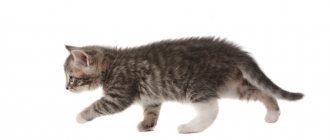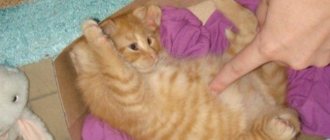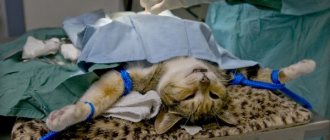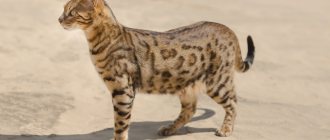He bites his tail because there are fleas or other diseases
One of the most common reasons why your cat bites her tail is because she simply has fleas.
The itching caused by these animals causes the cat to chase and bite its tail to relieve discomfort.
But this situation can occur not only from fleas, but also from itching caused by other reasons, such
as:
- Problems in the anus
- Food allergies
- Arthritis
- Intestinal parasites
- etc.
Either way, it is important that you go to a veterinarian to have him examined and determine if the cause of his behavior is caused by an external agent that may be causing this itching.
Diagnosis and treatment
After discovering lost hair, it is necessary to urgently show your pet to a veterinarian, since at home there is no way to understand the cause of the disease. To make a diagnosis, the veterinarian will carry out the following procedures: collect anamnesis (interview the owner about past diseases, nutrition); conduct an external examination for the presence of characteristic symptoms; will take blood and skin scrapings for study. If necessary, ultrasound diagnostics are performed. After determining the cause of alopecia, the doctor prescribes treatment recommendations:
- Fleas. Elimination of parasites is carried out using shampoos (Fitoelita, Lugovoy, Celandine), drops on the withers (Stronghold, Advocate, Bars), sprays (Delix, Frontline). For prevention, it is recommended to wear a flea collar.
- Lichen. Treatment is usually local - shampoos (Doctor, Alezan, Antifungal), ointments (Yam, Sanderm), Fungin is effective. Vaccines are common for treatment and prevention - Polivac, Vakderm.
- Avitaminosis. If the animal is fed natural products, it is recommended to add a vitamin complex. It is better to give pregnant cats special food designed for this condition. Sometimes doctors prescribe sulfur preparations and immunostimulants.
- Hormonal imbalances, dermatitis, stress - specific treatment depending on the identified problem.
- Inflammation of the paraanal glands. Treatment – massaging the anus area from the outside or inside, treatment with an antiseptic through a catheter. If necessary, antibiotics and rectal suppositories are prescribed to relieve inflammation.
- Allergy. The irritant is eliminated and antihistamines are given.
If your cat's tail comes off, then the best method of preventing this symptom is prevention. It is enough to provide adequate feeding and care, regular examinations and monitoring of the pet’s condition.
Boredom or stress may also be a cause
But not only for health reasons, your cat is biting its tail,
but psychological factors may also intervene to cause the animal to ultimately behave this way.
A cat may end up biting its tail because it is bored
. If you find that she begins to chase him at certain times of the day, it is best to start playing with her to avoid injury. You can play by buying a special toy for these animals or creating them yourself using materials you have at home.
Another reason is that the animal is stressed
and hence begins to bite the tail as a compulsive act. It is important that you stop and relax it, so that you can live calmly and without worry. The cause of stress for a cat can be many factors: a change of home, the arrival of a new member in the family (both animal and new person), noise, etc. It is best if you adapt the place in your home so that the animal can be relaxed and calm, and you will see how gradually it stops biting its tail.
Treatment
Providing first aid to a pet in a timely manner can save its life. If there is a fracture, the cat should be placed at rest and carefully transported in a carrier, taken to a veterinarian. After the examination, an x-ray is taken and the necessary medications are prescribed. In some cases, a cast is applied.
If scratches and wounds occur or hair loss occurs in the tail area, sulfur ointment is used, which is sold at any pharmacy. It does not dry out the skin and promotes rapid healing.
The most common problem in domestic cats is worms. Anti-inflammatory agents and a proper diet with the addition of vitamins can help remove them, which will not only have a beneficial effect on health, but will make the coat smooth and silky.
Cats play to chase each other's tail
Another reason why an animal has the habit of chasing and biting its tail is that it is simply playing
. Consider that they are generally calm and usually sleep many hours a day, so from time to time, at the moment when they want to be activated, they may start playing with anything: fluff, paper and even their own tail.
In this case, you don't need to deprive him because he only wants to play. Although you can pay more attention and play with him so as not to hurt him.
Opinion of zoopsychologists
A cat, no matter how long it is next to a person, remains at heart a predator driven by hunting instincts. When a little kitten plays with his tail, he learns to track, chase, and catch nimble little furry prey. Chasing the tail is the first step to successful mouse hunting. The baby catches the tail of his mother and his brothers and sisters with equal enthusiasm.
A kitten is born with instincts “written” in its genes. He plays in order to:
- study;
- hone the skills of a hunter;
- improve mentally and physically;
- maintain physical fitness.
Desire to hunt and play. In conditions of limited space, domestic cats cannot realize the hunting instinct and exchange the missing object for an analogue (according to the cat's understanding). After all, the fluffy moving tail looks so much like a mouse.
Animal psychologists consider this behavior to be the norm in kittens. In adult cats, chasing their own tail is also a favorable sign. Only a calm cat happy with its life has the desire to play.
Owner actions.
If the owner is concerned about the cat's desire to chase its tail, it is worth taking care of the toys.
The animal needs to play, and there is only one object at its disposal - its tail. By buying a pet a fur mouse, a ball or a feather tassel and spending time playing with the pet, the owner will not only keep him busy. Researchers say that playing together strengthens the psycho-emotional bond between humans and pets.
Attract attention
It is also possible that the animal has this behavior because it is jealous
the arrival of a new person in the house. Cats are very territorial and don't take change well, so if a child arrives or sees a new animal in your home, it's best to spend some time introducing yourself and letting your cat get used to this new presence.
In this sense, the animal will bite its tail only to attract attention
. Although they are very independent, the truth is that they place great importance on love and want to feel loved. Therefore, if they feel that you are paying attention to other members, they may act in this peculiar way.
Physical problems
Veterinarians focus on the health status of the pet if its behavior is a symptom of disease. The reason for chasing your own tail can be pain, itching, burning caused by:
- parasitic diseases – worms, fleas, ticks;
- inflammation of the paraanal glands;
- anal herbs;
- constipation;
- skin diseases;
- allergies to food;
- tail injuries - fracture, bites of other animals, compression, torn ligaments;
- mental disorders, for example, the consequences of brain injuries and infections.
Trying to get rid of painful sensations, the cat diligently licks and chews its tail, until bald spots and wounds form.
It is necessary to pay attention to such behavior in a timely manner.
Also watch the video why a cat chases its tail:
Announcements on NN.RU - Home
Synology 210j 2-disk network drive Number of HDD spaces: 2 Maximum volume: 12TB (2x6TB) Form factor of HDD spaces. Price: 5,000 rub.
radio components reception. Microcircuits capacitors, transistors, connectors, switches, lamellas, etc. expensive. Price: 50,000 rub.
Travel to any area of the city is free, we work even on holidays. We will repair any TV and provide a guarantee of up to 20 months. Fast and... Price: 500 rub.
Professional repair of any TVs (LCD, plasma, projection, picture tube) Thomson, Samsung, LG, Rolsen, Rubin, Philips. Price: 500 rub.
How to stop the habit
You can stop your cat from sucking its tail in the following ways::
- Offer your fluffy a “tail substitute.” You can use a toy or choose another thing that is safe for your pet.
- Using bitter-tasting solutions (not poisonous!). This approach is recommended if the animal is harming its furry cane. By licking the bitter solution, the cat will eventually wean itself from chewing its tail. But there is another problem: the pet can become irritable and even aggressive. The owner needs to be attentive to his four-legged friend during this period. Deprived of its usual joy, a cat needs additional portions of affection, especially before bed. During these minutes, the owner must help the pet calm down and fall asleep without a “pacifier.”
Source
In what cases is it necessary to consult a veterinarian?
If there are some accompanying symptoms, an animal actively licking itself or licking its nose should be shown to a veterinarian. The following signs should not be ignored:
- lethargy and lack of response to external stimuli;
- decrease in physical activity;
- increased body temperature;
- complete or partial loss of interest in food and, accordingly, weight loss;
- deterioration of the coat (thinning or hair loss);
- the appearance of sores and scabs on the skin;
- increased thirst;
- disruption of the digestion process and bowel movements;
- refusal of water;
- signs of intoxication and dehydration of the body;
- frequent vomiting.
You should not treat the animal yourself. Inept actions can aggravate the problem, so it is better to entrust the identification of the cause of the disease and the development of a treatment regimen to a veterinarian.
Absolutely every cat, regardless of breed, age and living conditions, tries to keep itself clean. Therefore, every day the pet is carefully licked several times - its fur coat, body, each paw in turn, tail and genitals. But sometimes the completely natural process of grooming an animal takes on the character of an obsession, and the cat constantly licks, and the reasons for this behavior are not always clear. This needs to be sorted out.
Cats usually lick and groom themselves after sleeping or eating. And this is normal, since cats are very clean by nature. But it happens that a cat begins to lick a specific place longer and longer. And for each situation there are reasons.
The cat licks his wounds
Group: Participants Messages: 43 Registration: 1/19/2012 Tails: 2 City Nakhodka (Primorsky Territory) User No.: 18166
Thank you said: 14 times
Sister's cat, help me figure this out.
1. Boy, 1.5 years old, 5.5 kg 2. Neutered 3. No vaccinations 4. Date of last deworming was September 15, they don’t remember the name of the drug, suspension 5. Royal Canin is hypoallergenic for more than a month. Previously, heals for castrati. He drinks enough water from the tap. Urination is normal, stable, once a day, stools are of normal consistency, formed, not dry, once a day. 6. The temperature is normal, it never rose 7. At the beginning of October, the flea collar was removed (they were worn in the spring for prevention, there were no fleas) and after 3-4 days the cat began to lick the skin until there were bleeding wounds in the area of the knees and left thigh. We went to the veterinary clinic, where they assumed that he had injured himself and told him to treat him with fucorcin. We treated and observed the cat for about a week, but the reasons for this injury were not found. The cat continued to lick the wounds and they increased in size. Licked wounds also began to appear on the front paws. We went to a veterinary clinic again, this time to a different one. They assumed it was flea dermatitis (although no fleas were visible, they live on the 4th floor), they told me to treat the fleas and put on a new collar. We bought the drug “Dana”, but for puppies (the pet store did not have the drug for cats, they said that the cat is large and can be used for puppies) and dropped a couple of drops on the withers according to the instructions for weight. The cat immediately began trying to lick the drug. But he couldn't reach it. The cat was restless for days, did not sleep at night, woke up the owners, and kept trying to lick off the drug. A day later, he was washed with regular cat shampoo to wash off the drug, because the cat’s reaction was clearly abnormal. He became noticeably calmer, but now he tried to scratch the place where the drug was and fur began to come out there. The skin in this area began to get wet. The cat combed this place with its paw, all the fur came out in a patch. The skin was constantly wet and irritated in this area. We went to the doctor again. They said that the drug could not be used for puppies and that you just had to wait for it to heal, not let it be licked, and treat it with peroxide. At this time there were also wounds on the paws, but apparently they bothered the cat less. After the treatments, the wound began to dry out and a crust had already formed, but after a few days the cat scratched it until it bled again. Then they sewed a blanket for him so that he could not comb his hair. After about a week, the wound healed. There were wounds on the legs all this time, they did not heal completely, the cat constantly licked them a little. We went back to the doctor at the clinic. They wanted to scrape it, but since the wounds were dry, the doctor said there was no point. They gave him a collar to prevent the cat from licking the wounds and prescribed a “Stop Itching” course. After that, after about a week, everything had practically healed and the cat’s collar was removed. While the owners were at work, the cat again licked his knees to the point of bleeding wounds. We went to the doctor again. They told me to switch to hypoallergenic food and told me to wear a collar again. Switching to a new food did not make things better. the small bag of food ran out, we bought exactly the same food, but in another store and the cat began to go to the toilet loosely for about 4 days, everything returned to normal on its own, the food was not changed. But my skin didn’t get any better. The cat has learned to lick its paws and collar. They made him a jumpsuit. Nothing helped, I still licked it both in the collar and in the overalls. We went to get tested again to the doctor. On the same visit, the cat was given the first injection of Otodectin, because parasites were suspected. Based on the test results, the doctor said that there was inflammation and some kind of allergic reaction. After 10 days, they injected 2 injections of “otodectin”. And they prescribed “stop stress”. But it doesn't get any better. In general, the cat is active and his appetite is normal. Only sad when they wear overalls. But even in a collar he already behaves actively if without clothes. The owner notes a wave-like flow, at times the wounds dry out, then again he licks them more actively. Treatment has no effect on this. It turned out to be a lot of text, but it all lasts so long and we just give up ((((What else can we guess. And the veterinarians have already gone through everything in our small town ((( 8. Test results (norms, unfortunately, are not indicated) hemoglobin 123 red blood cells 5.8 ESR 4 Leukocytes 11.6 Basophils 2 (increased) Eosinophils 12 young 0 rods 8 segments 43 lymphocytes 28 monocytes 7 (increased) Basophilia, monocidosis 9. Prescribed drugs indicating dosages, frequency and method of administration “Stop- itching” took a course according to the instructions “Otodectin” 2 subcutaneous injections in the withers area with an interval of 10 days “Stop-stress” is now taken according to the instructions, 3 drops in the morning and 3 drops in the evening (they have already been taking it for 10 days, there is no effect)
